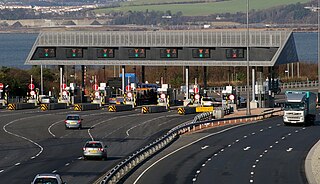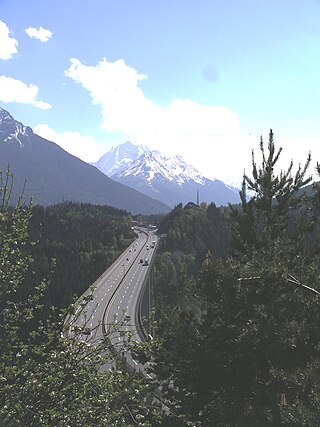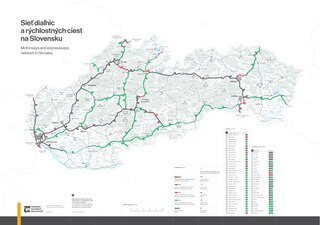Vignette obligation by country
European Union
The Eurovignette Directive introduced in the European Union in 1993 governs road tolls for trucks of minimum 12 metric tonnes. [3] [4] An international agreement, based on Article 8 of the Eurovignette Directive, signed in 1994 by Belgium, Denmark, Germany, Luxembourg, and the Netherlands established a common system of vignettes within the Eurovignette framework. [5] Sweden signed a protocol to accede to the agreement in 1997. [6] Germany denounced the agreement in 2017, while Belgium denounced it in 2019. [7]
Austria

Since 1997, vignettes are required for all vehicles of up to 3.5 tonnes, driving on motorways and expressways (prefixed with letters A and S) under federal administration. Vignettes are overseen by the police and toll-sheriff employees of the federal motorway administration. A €240 fine with an additional obligatory payment of a substitute toll are charged to travelers without a valid vignette, and unpaid fines lead to penalties between €300 and €3,000. Furthermore, the vehicle may be confiscated from foreigners to guarantee payment of the penalty.
Additional tolls are charged for certain motorway sections where tollgates and video tolling systems are installed. Several sections require drivers to buy electronic toll cards. Vignettes for vehicles of over 3.5 tonnes were replaced with electronic distance-based highway-toll GO-Boxes on 1 January 2004. [2] Since 2019, electronic vignettes have been made available in addition to the traditional stickers.
Bulgaria

Vignettes are required for all (except motorcycles) vehicles driving on all public roads, with the exception of streets in cities, towns and villages. Vignettes are usually valid from the time they are purchased, while some types can be marked to start from a future date. They can be obtained in Bulgaria at most gas stations, at border crossings, or online using a credit card. [8] Cash fines from €150 to €1,500 are charged to drivers without a valid vignette. [9] The vignette sticker was replaced by e-vignette on 1 January 2019, and an e-toll system is to be introduced in August 2019 for vehicles heavier than 3.5 tonnes. [10]
Czech Republic

Vignettes are required for the use of motorways and expressways by all vehicles of up to 3.5 tonnes. Cash fines for not displaying a valid vignette affixed on a car's windshield range from €80 to €200. Vignettes for heavier vehicles were replaced with electronic toll collection in 2007. By 1 January 2021, the vignette stickers were replaced by digital vignettes. [11]
Germany
Motorways and expressways are a toll-free road network for all lighter vehicles. The Eurovignette system for trucks was abolished in August 2003. A distance-based toll charge was introduced from 1 January 2005 for vehicles of over 12 tonnes, operated by the Toll Collect company.
As of 1 March 2007, all drivers are required to purchase an emission sticker when passing through low-emission zones in several cities and municipalities. Certain "green zones" have completely disallowed entrance to vehicles with higher particle emissions ("yellow" and "red" groups). Travellers passing through these areas without the sticker are charged with a €100 fine. [12]
Hungary

Vignettes are required for all vehicles on motorways and expressways. Physical toll stickers were replaced with electronic vignettes and video tolling on 1 January 2008, the only physical item the purchaser receives is a control coupon. Motorway usage entitlement is verified by roadside cameras based on license plate numbers, and drivers of vehicles up to 3.5 tonnes without a valid vignette are charged with cash fines between €50 and €200. [13]
Moldova
Vignettes are obligatory for personal motor vehicles registered abroad, driving on public roads, and are available for purchase at border customs posts and offices. Foreign drivers without a valid vignette are charged with cash fines between €125 and €375. Heavier vehicles use existing tax rates, with commercial vehicle drivers paying a single-entry tax and a distance-based charge. [14]
Montenegro
Ecological-tax vignettes were abolished on 31 December 2011. Driving on public roads is generally toll-free, with the exception of passing through certain tunnels and bridges. [15]
Romania

With the exception of motorcycles, vignettes are required for all vehicles driving on all national roads and motorways. Physical vignettes have been replaced with electronic ones since 1 October 2010. [16] They can be obtained at most gas stations, border crossings, or online using a credit card. Drivers without a valid vignette are fined with €100 or more. The fines are dispensed by automatic systems that scan the numberplate of the car when it exits a city. [2]
Slovakia
Vignettes are obligatory for all vehicles of up to 3.5 tonnes, driving on Slovak motorways. Drivers without a valid vignette are charged with cash fines between €100 and €500. Vignettes for heavier vehicles were replaced with distance-based electronic toll collection using the remote-operated toll-box in force since 2010. Special arrangements are to be sought by the motorbike riders. [2]
From 1 January 2016 Slovak vignettes are purchased and checked electronically via eZnamka.sk without a sticker.
Slovenia
Vignettes are required for all vehicles of up to 3.5 tonnes, driving on Slovenian motorways as of 1 July 2008. Drivers without a valid vignette are charged with cash fines between €300 and €800. On 1.4.2018, Slovenia implemented an electronic tolling of vehicles whose maximum permissible weight exceeds 3.5 tonnes. [1]
From 1 December 2021 Slovenian vignettes are purchased and checked electronically via evinjeta.dars.si without a sticker.
Switzerland
All travelers using motorways and expressways are required to purchase an annual vignette. Vignettes can be obtained in and outside of Switzerland in bordering countries at gas stations and labeled points. Use of motorway networks without a valid vignette is an offense against the Public Highways Act, and is punishable with cash fines of CHF 200, in addition to the obligatory purchase of an annual vignette. [1] Heavier vehicles use a distance-based tax rate on all types of roads, called the performance-related heavy vehicle charge .
Switzerland only offers a vignette valid for a year (from December of the preceding year to the January of the following year) at CHF 40 (€35.75). Because of this, its vignette is the most expensive in Europe for transiting and visiting passenger cars. Other countries offer short-term vignettes that make a transit or visit less expensive than in Switzerland. [17] [18] [1]














